Are you feeling mixed emotions about using ChatGPT for marketing and business?
You’re not alone.
What the creators of this text-to-text generative AI have accomplished is incredible. Using ChatGPT is almost like being able to hold a conversation with a search engine that can help you generate ideas while also creating usable content.
Almost.
To better understand the best ways to use ChatGPT for marketing, we need to know what we’re dealing with.
ChatGPT is a natural language processor that can “chat” with a user much in the same way we talk with other people.
This artificial intelligence (AI) system was trained using large amounts of text from the internet and models its responses based on this information. It also continues to learn with each “conversation” it has with users.
As with any tool, ChatGPT does have some issues. Here are some things to know before using ChatGPT:
- It has a tendency to make things up (called AI “hallucinations”) so all output needs to be checked for accuracy and relevance.
- It cannot actually search the internet, and its current knowledge base (as of 2023) does not contain information past 2021, which limits tasks it can perform that require more up-to-date data.
- Its creators cannot guarantee the security of the platform, which means any private or proprietary information users enter could be accessed by people who would use that information for dishonest or criminal purposes.
- It is likely to incorporate harmful marketing tactics like manipulative language, embellishment, and pressing on pain points because that is the type of marketing most popular in the online texts it was trained on.
- It can reflect human biases, particularly against historically marginalized populations, because the data that it was trained on (and continues to train on) is filled with those biases.
- Its output tends to lack the personal touch and empathy only a human can provide, so any content it gives you will need to be revised to stay in integrity and authenticity with your brand voice.
Open AI, the creator of ChatGPT, is aware of these limitations and now displays them on the screen when new users create an account, as seen below:
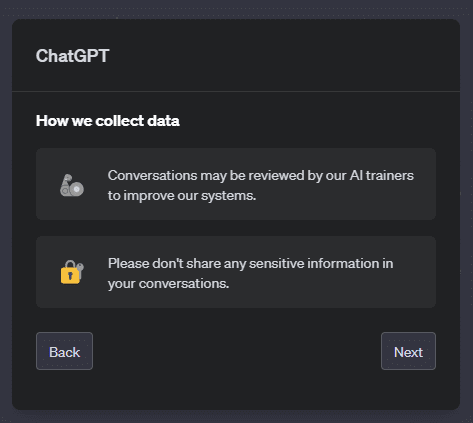
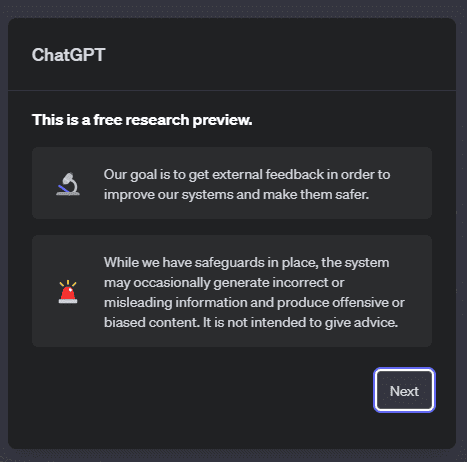
These pop-ups warn users not to share sensitive information on the platform and that ChatGPT may occasionally generate misleading or biased content.
That’s not to say that tools like ChatGPT aren’t worth your time.
Despite its drawbacks, ChatGPT can be a powerful tool for marketing productivity.
ChatGPT can help streamline marketing tasks for those businesses using a DIY digital marketing strategy. Use it for things like…
- Generating a list of potential content topics. Brainstorming has its place, but there’s no harm—and a lot of potential benefit—to speeding up the process by having ChatGPT give you a jumpstart.
- Pushing past the barrier of the blank page. That blank white screen of possibility can be intimidating. Get some clear direction by feeding ChatGPT a basic outline and asking it to fill in the blanks—or even asking it to generate the outline for you.
- Creating some basic questions for a poll or survey. These types of questions don’t need to be complicated to fulfill their purpose. ChatGPT can get you started on some basic questions, which will give you more time to add some that are more specific to your brand.
- Drafting automatic replies for a chatbot or email autoresponder. As with the survey questions, there are some general responses most people expect to see with a chatbot or email auto-reply. Save time by having ChatGPT generate them for you and then revise them to fit your brand voice.
- Producing questions for an FAQ page. They’re called frequently asked questions for a reason—mostly because they are common questions industries expect to receive from their customers. When you don’t yet have a real-life audience to pull from for specifics, ChatGPT can get you started with the basics.
Essentially, ChatGPT can be an amazing writing assistant—when you understand how to use it.
Before we dive deeper into exactly how to use this technology for these tasks, let’s look at what ChatGPT is and what it isn’t.
ChatGPT is a powerful tool that will only continue to evolve. We need to find a balance between seeing it as an answer to all our problems and ignoring it because we don’t understand it.
It isn’t necessary or advisable to go all-in on this technology today, even if it seems like everyone around you is doing just that.

No one—not the internet personalities droning on about it, or even the creators—has fully explored the most effective ways to use ChatGPT or similar technologies. Nor does anyone know how this is going to shake out over the next decade.
Just like with every other disruptive technology before it, there is time. Don’t let FOMO cause you to regret moving too fast.
At the same time, we should not overlook what this technology can do. It will fundamentally reshape how we do business over the next decade.
As Rand Fishkin of Sparktoro puts it, “AI-generated content is the new floor” that marketers and business owners must consider when deciding what’s worth putting out into the digital space. So, it’s good to know what AI can do.
I predict that content not powered by AI will go the way of content that doesn’t target keywords or consider what the audience is looking for.
In other words, it won’t get the results you’re looking for.
So, now is the time to approach using ChatGPT for marketing with a beginner’s mind.
Take this time to play.
To learn.
To watch.
To experiment.
Discover what works best for your brand and your team.
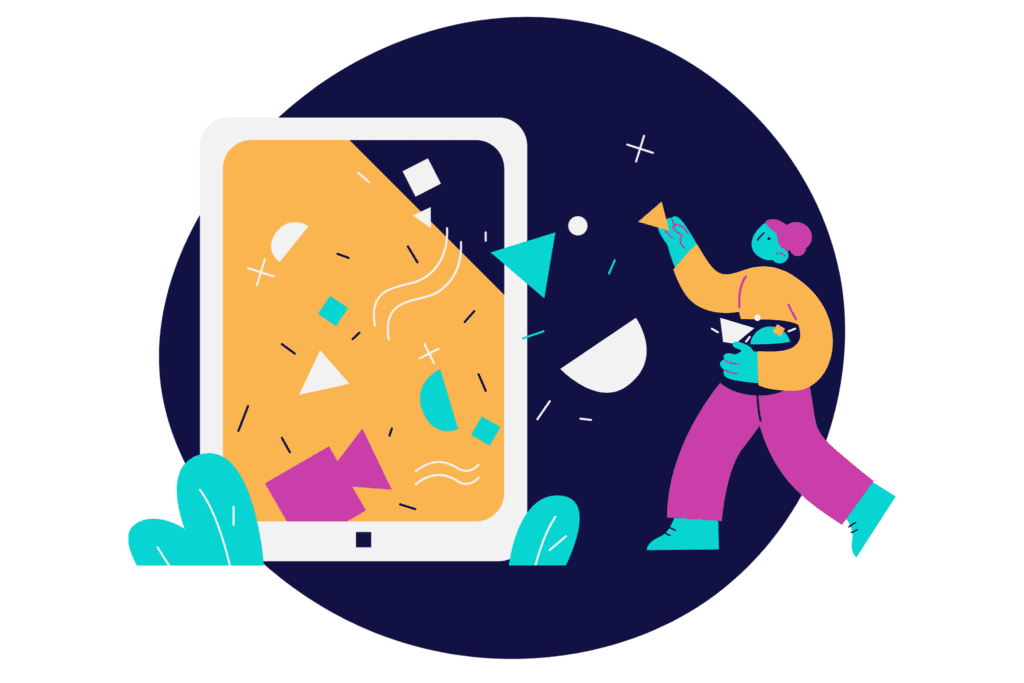
Once you’ve determined how to make ChatGPT work for you, you could use it to streamline some of your marketing production tasks—giving yourself space to focus more on things that bring you joy.
At Realign Consulting, we have been experimenting with how ChatGPT fits with our Do Better Business™ model of values-driven sustainability.
We believe your business should work for you, not the other way around. True sustainability happens when you put people first, systems second, and innovation third.
The first rule of values-driven marketing is to Do No Harm. Innovation, such as using ChatGPT, should not come at the expense of your team or the communities that you serve.
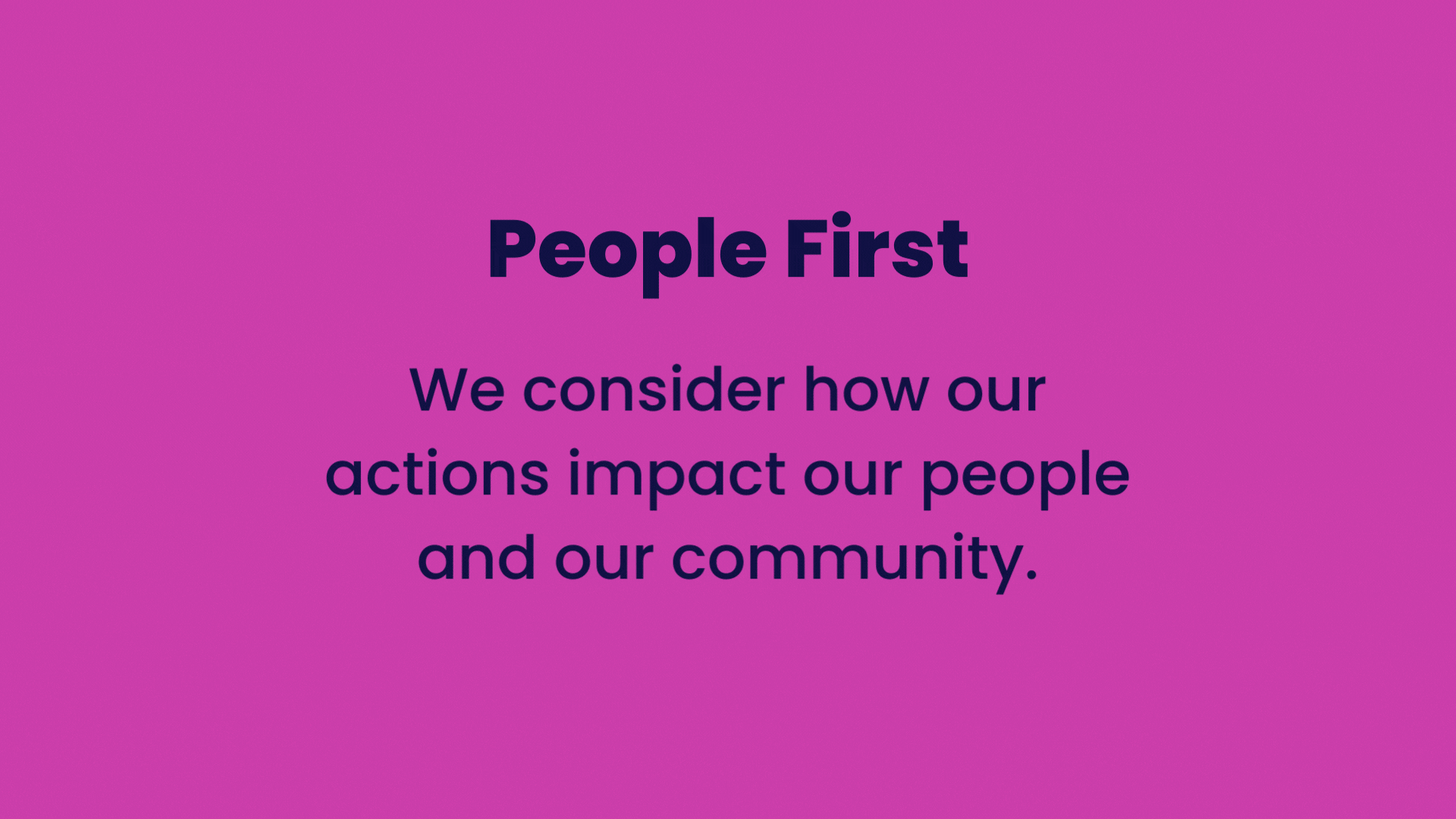
There is great potential for harm with this technology. As I listed earlier, ChatGPT can introduce biases, misinformation, and manipulative marketing tactics into your content that you otherwise would not include. It can also expose private or proprietary information to people who would use it dishonestly.
If you are dedicated to a values-driven marketing strategy, consider this question:
How can we use ChatGPT for marketing without compromising our values or creating more work for our team?
- First, it is important to know where your line is. What things will you not do or say in order to stay in integrity with your values? Is your team trained to recognize when that line is being crossed?
- Second, decide how much time you are willing to dedicate to learning this new tool. Ultimately, it should be used for tasks that will ease the load for you and your team while also providing value for your clients. What tasks can you experiment with that match these criteria?
Once you’ve made those decisions, it’s time to start experimenting.
Ultimately, we saw that the best way to use ChatGPT for marketing help is to focus on written content creation and optimization.
After all, it’s not just an AI—it’s also a large language model system. So, it makes sense that it would be the most helpful for planning, structuring, and optimizing language.
I am especially excited about ChatGPT’s uses for writing because I have long endorsed a values-driven, copy-first marketing strategy for most small and micro businesses.
(Copy is writing that sells or persuades, while content writing educates and builds relationships. There is a lot of overlap in the digital space.)
I advocate for a copy-first marketing focus because words are the primary way we connect with our audience. Plus, copy tends to be the most sustainable marketing focus for many small and micro businesses.
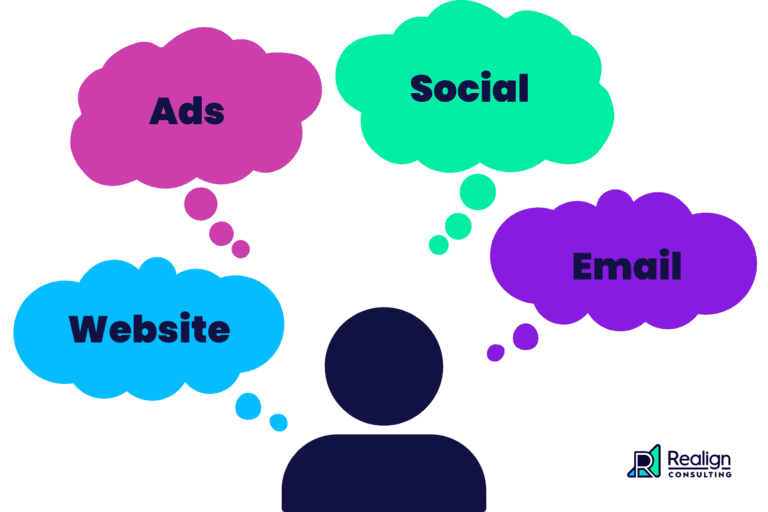
Our words show up everywhere our brand does, and they are our most powerful asset.
However, my team and I will be the first to agree that writing, revising, and updating copy can be time-consuming (and occasionally frustrating).
As a large language model processor, ChatGPT can help streamline our work to ensure we deliver quality content promptly without overwhelming our small team.
Listed below are five ways you can use ChatGPT for marketing to lighten the load for your team while maintaining a competitive edge in your industry.
Remember, using AI in your business isn’t all or nothing. If you’re new to ChatGPT, choose one of the ideas below to experiment with. The goal is to find something that adds value to your work and creates more space for things you enjoy.
Idea #1: Use ChatGPT to generate or refine content ideas.
When it comes to brainstorming ideas for content creation, two heads are better than one.
ChatGPT can act as a sounding board for new ideas, give direction to your research, or help you break down a complicated topic so you can explain it to your audience (or simply help you understand it better).
Of course, all claims must be fact-checked, and not every idea the algorithm offers will be worth your time.
But for the lone writer at her keyboard, ChatGPT can help to get those creative juices flowing.
Let’s say that you offer a service to homeowners in your local community and you want to create a blog that discusses industry related topics that your customers would find useful.
You could start by listing the first few topics that come to mind based on your past experience with customers.
Then, ask ChatGPT to generate more ideas, using your current list as example. With all the data it has to pull from, it will likely think of things that you have not.
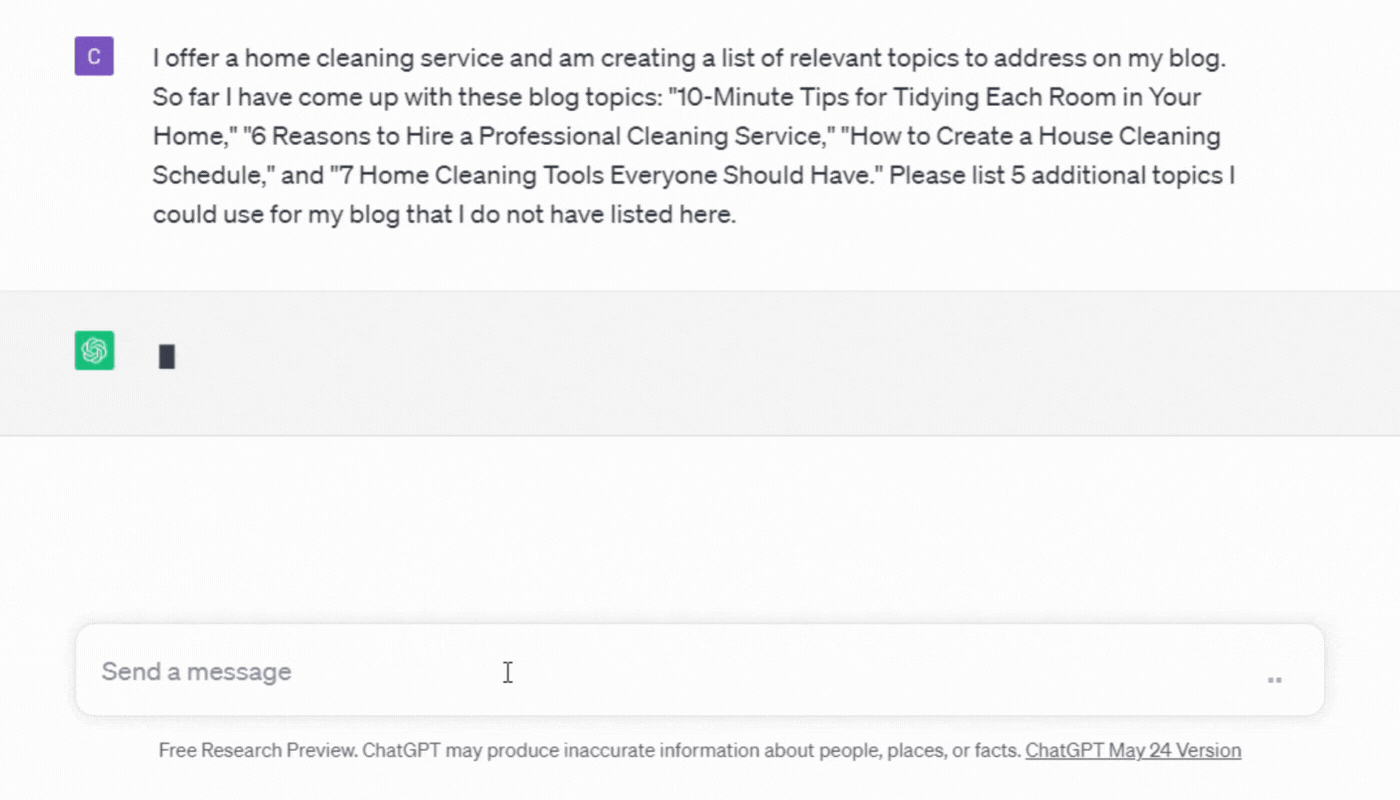
From there, you can sort through the now much longer list to decide on the best topic to start with.
Idea #2: Use ChatGPT to kickstart or tweak your content.
Content created by ChatGPT should not be copied, pasted, and published as is. As I mentioned above, it is unlikely to match your brand voice, and it should at least be checked for accuracy, relevancy, and language that does not go against your values.
But every writer has been stumped by a blank page, and ChatGPT can help you overcome that hurdle.
Use this natural language processor to help with different stages of the writing process for your social media posts, product descriptions, ad copy, emails, or blog articles.
Let’s say you’ve chosen one of those earlier blog topics to start writing about. You could then have ChatGPT create subtopics for an outline or even have it generate that outline, as seen in the graphic below.
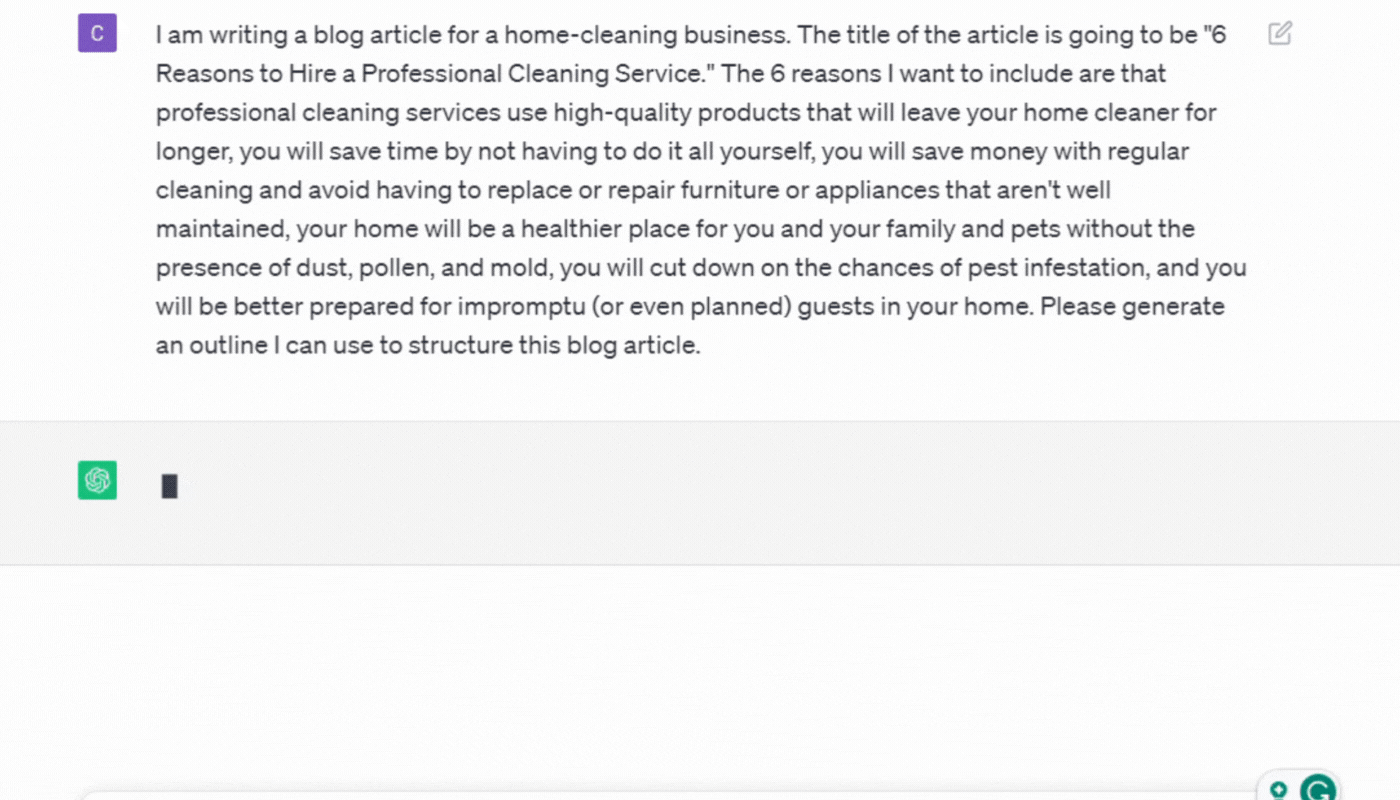
Or, maybe you have no problem creating the outline, but you’d like help with the first draft. You could prompt ChatGPT to generate something based on your outline, audience details, and overall goal for the piece. The more specific you can be in your prompt, the better.
Remember, this “crappy first draft” will still need to be revised to accurately reflect your brand.
Be sure to check ChatGPT’s output for…
- Specific language that does not gloss over important information
- Accurate details, quotes, and references
- Relevant examples and appropriate word choice
- An engaging tone of voice that is true to your brand
- Readability for the digital space (short sentences, simple language, and plenty of white space)
Recently, we wrote a short article for one of our clients about her experience with a business management intensive she had recently completed. We gave ChatGPT a great deal of information about the program and prompted it to help us summarize it.
Its output was okay—if a bit wordy—but it included an inaccuracy. One sentence stated that the program included “seven learning sections,” when the number was actually nine.
Fortunately, we caught the mistake. But it was a good reminder to double-check everything that ChatGPT generates. If your content contains inaccuracies, misinformation, or falsehoods, it could tarnish your brand’s authority and trustworthiness.
Idea #3: Use ChatGPT to create questions for an audience poll or survey.
Truly helpful audience research requires real-time data and interactions. But even a basic survey can provide direction for that research, and ChatGPT can get you started by generating a list of potential questions.
Let’s say you’ve been working on the draft for the blog post above. You’ve decided it could benefit from input from real-life customers. Specifically, you want to know why they hired your company, what they’ve found to be the greatest benefits, and what they would tell other people who are considering hiring you.
Once you have an idea of what you’re looking for, provide this context for ChatGPT and ask to generate a list of questions for a customer survey.
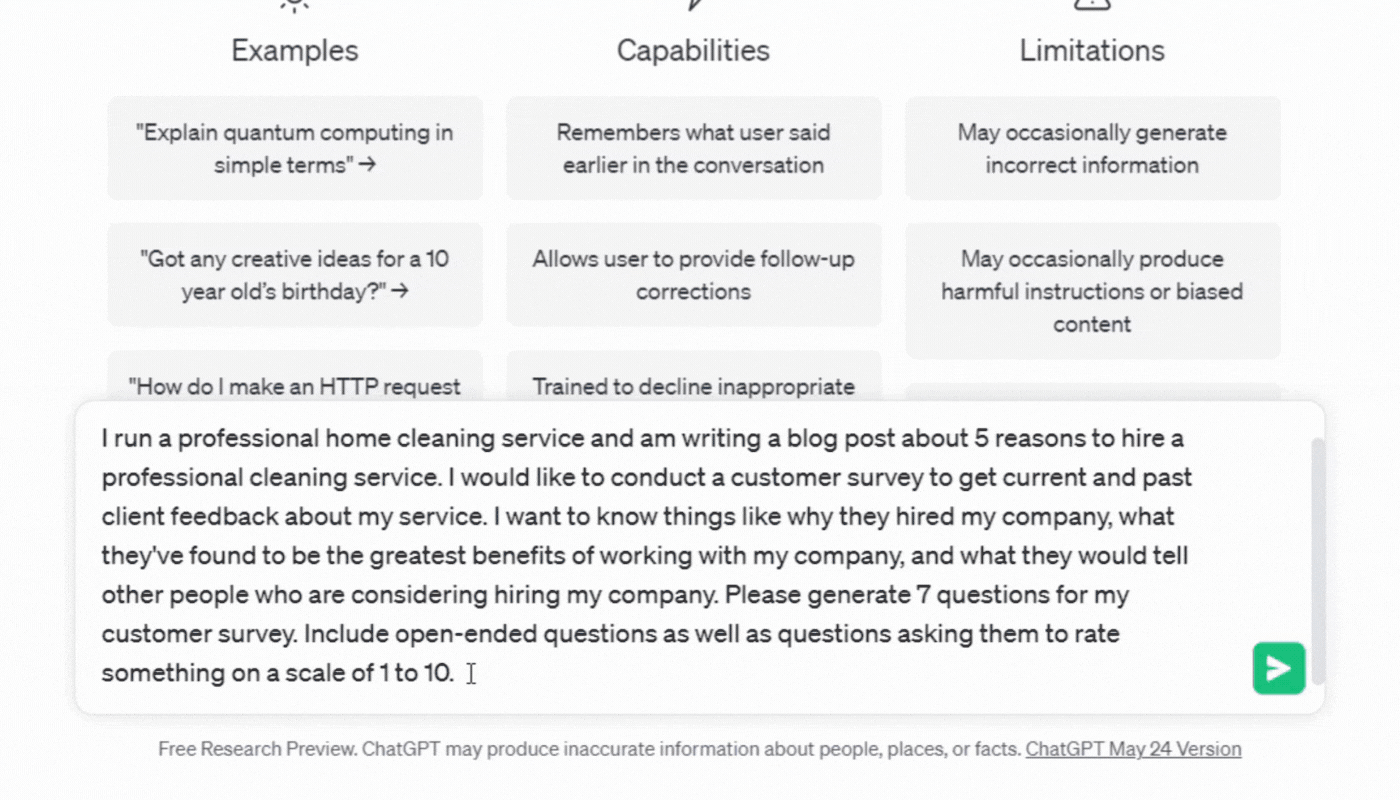
As always, be ready to revise what it generates. However, you may find that these basic questions may only need some tweaking.
Idea #4: Use ChatGPT to draft automatic replies for a chatbot or email autoresponder.
ChatGPT may not be the best tool when it comes to providing up-to-date information. But it can certainly be used to generate impersonal, evergreen content.
If you’re creating a script for a chatbot or automatic email replies, use ChatGPT to save yourself some time. These responses follow a pretty straightforward format—and you can always incorporate your brand voice into what the algorithm generates.
Suppose you have now completed and published your blog article, and you included a CTA at the bottom asking people to schedule a consult for that service.
Many chatbot or email service providers allow you to personalize your automated messages. Ask ChatGPT to generate those responses for you and adapt them to your needs.
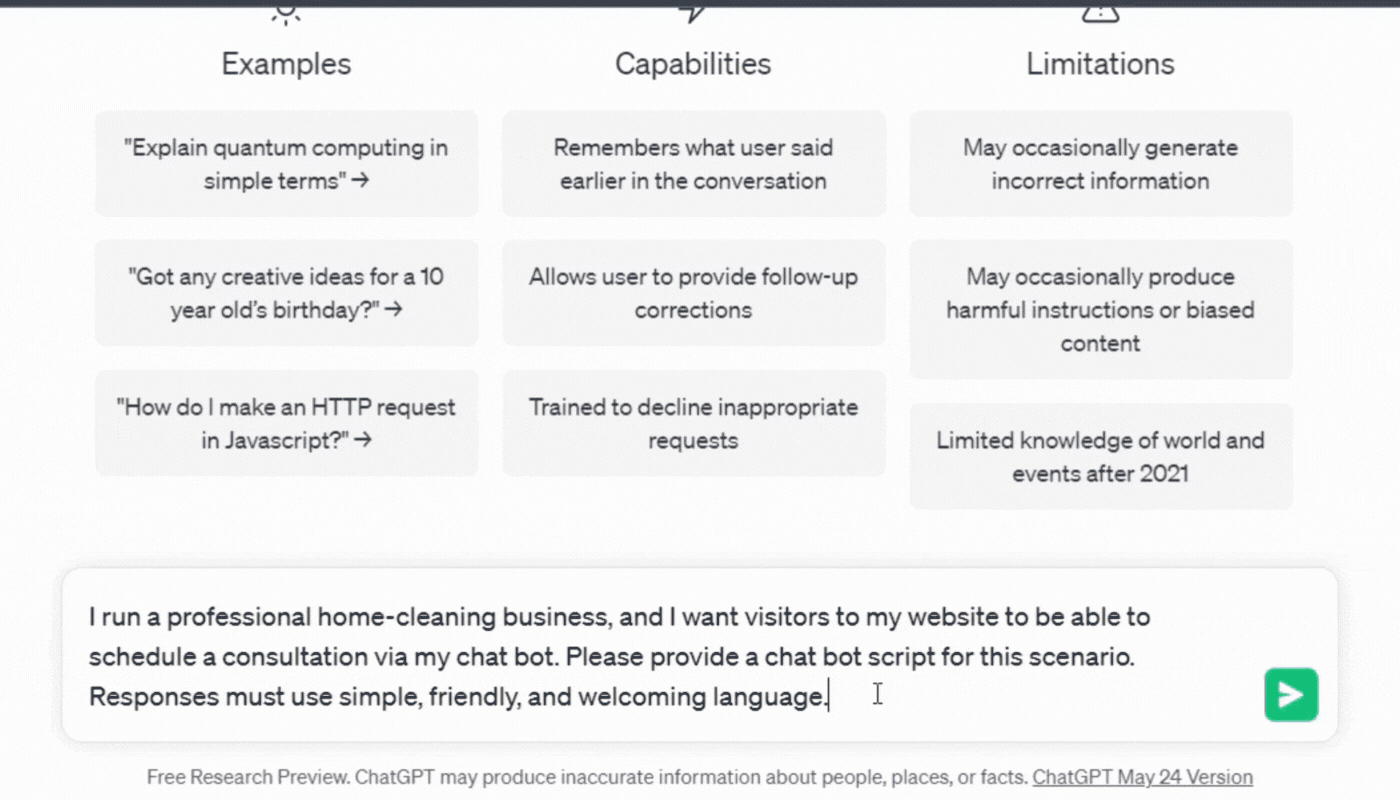
By using ChatGPT, you can more easily automate the scheduling process, save your team some time, and create a seamless experience for your customers.
Idea #5: Use ChatGPT to generate questions for an FAQ page.
A dedicated page or section for your frequently asked questions (FAQs) is a powerful tool for any brand. They can help you rank higher in search, increase traffic to your website, convince a potential customer to make a purchase, and generally build trust with your audience.
In our guide to building a copy-first strategy, I include tips for creating an effective FAQ page that performs well with your website visitors. I advise going straight to the source and basing your FAQs on what your audience is already asking.
However, if you’d like to add an FAQ section for a new product or service, it can be difficult to predict what questions your audience might have.
Once you tell ChatGPT about this product, it can get you started with some common questions. Then, you can optimize your page once you have real-world questions to add.
We’re currently planning a commercial services page for a local electrician. We asked ChatGPT to generate some FAQs to help us brainstorm what we might include on the page. While we could have come up with these questions ourselves, using ChatGPT saved us time and helped to ensure we had anticipated as many potential questions as possible.
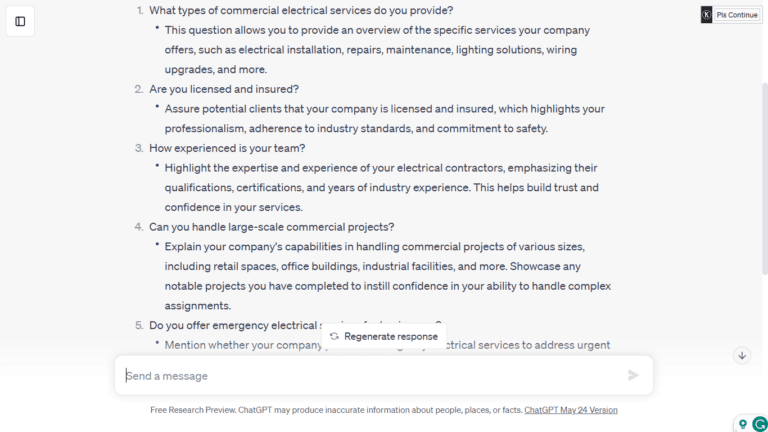
We now have questions to present to our client (because they don’t like starting with a blank page either, so providing content to work with respects their time).
They can sort through these questions, add their own, and provide the specifics we may need to answer them.
ChatGPT can be used for other marketing tasks, but only when paired with an appropriate tool.
There is a lot of advice about using ChatGPT for other marketing tasks that it really wasn’t designed for—but pairing it with other tools could still save you time and make these processes easier.
Below is a list of some of those tasks, why ChatGPT isn’t the best fit, and our recommendation for the tools or resources to use instead.
1. Keyword research. ChatGPT can generate a list of keywords to try. But it will not provide an up-to-date analysis of search volume, relevance, competition, or other factors. Try pairing it with tools like Semrush, Ahrefs, UberSuggest, or Moz.
Check out our Do Better Digital™ SEO Keyword Strategy package to see if it fits your needs.
2. Audience research. ChatGPT can kick off your audience research with general ideas and information. But it’s best to rely on surveys, interviews, and other current data from tools like Sparktoro for up-to-date information. (As mentioned above, ChatGPT can help with developing those survey questions.)
Check out our Do Better Digital™ Persona Community Report to see if it fits your needs.
3. Marketing strategy. Once again, ChatGPT can get you started in the right direction. But for specific how-tos, it’s best to turn to the experts with the most current information. (For example, the ChatGPT algorithm is unaware of Google’s move from Google My Business to Google Business Profile, an essential tool for local SEO.)
Check out our Do Better Business™ Coaching package to see if it fits your needs.
4. Reporting and analytics. Besides being limited in information, ChatGPT is missing the most vital ingredient for data interpretation: humanity. Data-informed decision making is critical for any business team, but it can be easy to focus solely on the numbers and forget the people we are trying to serve. AI is great for helping with organizing information in spreadsheets, but at this stage, it lacks the nuanced interpretive abilities of an experienced market data analyst.
Check out our customized small business dashboards to see if they fit your needs.
5. SWOT analysis. A SWOT analysis (which stands for Strengths, Weaknesses, Opportunities, and Threats) is an essential part of developing a strategic business plan. While ChatGPT may be able to offer some general insight, it does not have the real-world context to perform a personalized analysis for your business.
Consider scheduling a Strategic Planning Retreat to get the space you need to plan what’s next for your business.
When treated as an experimental tool, using ChatGPT for marketing can be valuable for tightly resourced teams.
I’m excited to see how tools like ChatGPT evolve as AI engineers address their limitations and challenges.
For now, it is worth experimenting with ChatGPT for marketing help that can build ease and joy into your business.
Join the discussion
How are you using ChatGPT in your business?
Share your ideas and get inspiration by joining the discussion on LinkedIn.


